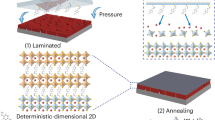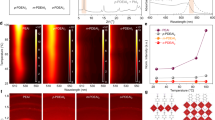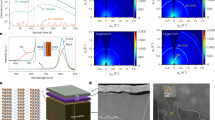Abstract
Two-dimensional surface passivation has been shown to be useful for achieving state-of-the-art perovskite optoelectronics, and the microstructural and phase heterogeneities of two-dimensional perovskite passivators can influence their roles. However, the synthesis of co-homogenized, stable microstructure and phase in such passivators remains challenging. Herein we leverage a [6,6]-phenyl-C61-butyric acid methyl ester molecular interlayer to mediate the reaction of the two-dimensional passivator and perovskite, leading to a uniform purer-phase two-dimensional perovskite capping layer. This interlayer mitigates the grain-boundary etching encountered in conventional approaches, creating molecular passivation directly onto the perovskite surface. The inverted perovskite solar cells made with the interlayer feature a laminate-structured perovskite heterointerface at the electron-extracting side, which contributes to improved charge energetics and film stability, owing to the regulated band alignment and laminate-layer protection, respectively. Power conversion efficiencies up to 25.97% are achieved, together with enhanced device stabilities under protocols standardized by the International Summit on Organic Photovoltaic Stability, showing T90 lifetimes (the time at which they maintain 90% of their efficiency) of over 1,000 h in both the damp-heat test (85 °C, 85% relative humidity) and maximum power point tracking under one-sun illumination. Lattice-resolved insights are provided to link the microstructure to device performance, shedding light on the significance of passivator-microstructure uniformity and reliability on the performance of perovskite optoelectronics.

This is a preview of subscription content, access via your institution
Access options
Subscribe to this journal
Receive 12 digital issues and online access to articles
$119.00 per year
only $9.92 per issue
Buy this article
- Purchase on SpringerLink
- Instant access to full article PDF
Prices may be subject to local taxes which are calculated during checkout




Similar content being viewed by others
Data availability
The authors declare that data supporting the findings of this study are available within the paper and its Supplementary Information files. Source data are provided with this paper.
References
Chen, S. et al. Trapping lead in perovskite solar modules with abundant and low-cost cation-exchange resins. Nat. Energy 5, 1003–1011 (2020).
Yoo, J. J. et al. Efficient perovskite solar cells via improved carrier management. Nature 590, 587–593 (2021).
Čulík, P. et al. Design and cost analysis of 100 MW perovskite solar panel manufacturing process in different locations. ACS Energy Lett. 7, 3039–3044 (2022).
Liu, X. et al. Perovskite solar cells based on spiro-OMeTAD stabilized with an alkylthiol additive. Nat. Photon. 17, 96–105 (2023).
Zhang, T. et al. Ion-modulated radical doping of spiro-OMeTAD for more efficient and stable perovskite solar cells. Science 377, 495–501 (2022).
Tan, Q. et al. Inverted perovskite solar cells using dimethylacridine-based dopants. Science 620, 545–551 (2023).
Chen, H. et al. Improved charge extraction in inverted perovskite solar cells with dual-site-binding ligands. Science 384, 189–193 (2024).
Ye, F. et al. Overcoming C60-induced interfacial recombination in inverted perovskite solar cells by electron-transporting carborane. Nat. Commun. 13, 7454 (2022).
Chen, J. et al. Efficient tin-based perovskite solar cells with trans-isomeric fulleropyrrolidine additives. Nature Photon. 18, 464–470 (2024).
Li, Z. et al. Stabilized hole-selective layer for high-performance inverted p-i-n perovskite solar cells. Science 382, 284–289 (2023).
Azmi, R. et al. Double-side 2D/3D heterojunctions for inverted perovskite solar cells. Nature 628, 93–98 (2024).
Azmi, R. et al. Damp heat–stable perovskite solar cells with tailored-dimensionality 2D/3D heterojunctions. Science 376, 73–77 (2022).
Jang, Y.-W. et al. Intact 2D/3D halide junction perovskite solar cells via solid-phase in-plane growth. Nat. Energy 6, 63–71 (2021).
Sidhik, S. et al. Deterministic fabrication of 3D/2D perovskite bilayer stacks for durable and efficient solar cells. Science 377, 1425–1430 (2022).
Zhong, Y. et al. Diammonium molecular configuration‐induced regulation of crystal orientation and carrier dynamics for highly efficient and stable 2D/3D perovskite solar cells. Angew. Chem. Int. Ed. 61, e202114588 (2021).
Yang, T. et al. Amidino-based Dion-Jacobson 2D perovskite for efficient and stable 2D/3D heterostructure perovskite solar cells. Joule 7, 574–586 (2023).
Chen, H. et al. Quantum-size-tuned heterostructures enable efficient and stable inverted perovskite solar cells. Nat. Photon. 16, 352–358 (2022).
Luo, L. et al. Stabilization of 3D/2D perovskite heterostructures via inhibition of ion diffusion by cross-linked polymers for solar cells with improved performance. Nat. Energy 8, 294–303 (2023).
Li, B. et al. Harnessing strong aromatic conjugation in low-dimensional perovskite heterojunctions for high-performance photovoltaic devices. Nat. Commun. 15, 2753 (2024).
Cai, S. et al. Atomically resolved electrically active intragrain interfaces in perovskite semiconductors. J. Am. Chem. Soc. 144, 1910–1920 (2022).
Cai, S. et al. Intragrain impurity annihilation for highly efficient and stable perovskite solar cells. Nat. Commun. 15, 2329 (2024).
deQuilettes, D. W. et al. Reduced recombination via tunable surface fields in perovskite thin films. Nat. Energy 9, 457–466 (2024).
Li, H. et al. 2D/3D heterojunction engineering at the buried interface towards high-performance inverted methylammonium-free perovskite solar cells. Nat. Energy 8, 946–955 (2023).
Zhou, Y., Herz, L. M., Jen, A. K. & Saliba, M. J. N. E. Advances and challenges in understanding the microscopic structure–property–performance relationship in perovskite solar cells. Nat. Energy 7, 794–807 (2022).
Chen, J., Quan, X., Lu, M., Niu, Y. & Zhang, B. J. U. Quantitative analysis method for nitrogen electron energy-loss near-edge structures in nanocarbons based on density functional theory calculations and linear regression. Ultramicroscopy 215, 113006 (2020).
Yan, L. et al. Fabrication of perovskite solar cells in ambient air by blocking perovskite hydration with guanabenz acetate salt. Nat. Energy 8, 1158–1167 (2023).
Hao, M. et al. Flattening grain‐boundary grooves for perovskite solar cells with high optomechanical reliability. Adv. Mater. 35, 2211155 (2023).
Suo, J. et al. Multifunctional sulfonium-based treatment for perovskite solar cells with less than 1% efficiency loss over 4,500-h operational stability tests. Nat. Energy 9, 172–183 (2024).
Ghasemi, M. et al. A multiscale ion diffusion framework sheds light on the diffusion–stability–hysteresis nexus in metal halide perovskites. Nat. Mater. 22, 329–337 (2023).
You, S. et al. Radical polymeric p-doping and grain modulation for stable, efficient perovskite solar modules. Science 379, 288–294 (2023).
Xiao, T. et al. Elimination of grain surface concavities for improved perovskite thin-film interfaces. Nat. Energy 9, 999–1010 (2024).
Mu, X., Mazilkin, A., Sprau, C., Colsmann, A. & Kübel, C. J. M. Mapping structure and morphology of amorphous organic thin films by 4D-STEM pair distribution function analysis. Microscopy 68, 301–309 (2019).
Roccapriore, K. M., Dyck, O., Oxley, M. P., Ziatdinov, M. & Kalinin, S. V. Automated experiment in 4D-STEM: exploring emergent physics and structural behaviors. ACS Nano 16, 7605–7614 (2022).
Doherty, T. A. et al. Stabilized tilted-octahedra halide perovskites inhibit local formation of performance-limiting phases. Science 374, 1598–1605 (2021).
Macpherson, S. et al. Local nanoscale phase impurities are degradation sites in halide perovskites. Nature 607, 294–300 (2022).
Ophus, C. Four-dimensional scanning transmission electron microscopy (4D-STEM): from scanning nanodiffraction to ptychography and beyond. Microsc. Microanal. 25, 563–582 (2019).
Wang, D. et al. Thickness scaling down to 5 nm of ferroelectric ScAlN on CMOS compatible molybdenum grown by molecular beam epitaxy. Appl. Phys. Lett. 122, 052101 (2023).
Almora, O. et al. Quantifying the absorption onset in the quantum efficiency of emerging photovoltaic devices. Adv. Energy Mater. 11, 2100022 (2021).
Jeong, M. et al. Stable perovskite solar cells with efficiency exceeding 24.8% and 0.3-V voltage loss. Science 369, 1615–1620 (2020).
Rothmann, M. U. et al. Atomic-scale microstructure of metal halide perovskite. Science 370, eabb5940 (2020).
Yang, C. Q. et al. Unveiling the intrinsic structure and intragrain defects of organic–inorganic hybrid perovskites by ultralow dose transmission electron microscopy. Adv. Mater. 35, 2211207 (2023).
Chen, S. et al. Atomic-scale imaging of CH3NH3PbI3 structure and its decomposition pathway. Nat. Commun. 12, 5516 (2021).
Acknowledgements
Y. Zhou acknowledges the Excellent Young Scientists Fund (no. 52222318) from the National Natural Science Foundation of China (NSFC); the General Research Fund (nos 12302822 and 12300923) and the Collaborative Research Fund (no. C2001-23Y) from the Hong Kong Research Grants Council (RGC); the NSFC/RGC Collaborative Research Scheme (no. CRS_HKUST203/23); and the startup grant from the HKUST. Y. Zhou also acknowledges the support from the China Merchants Group, particularly China Merchants Testing Certification International Co., Ltd. and China Merchants Research Institute of Advanced Technology Co., Ltd., for translating fundamental research to future technology innovation. S.C. acknowledges the startup grants from the Department of Applied Physics, Hong Kong Polytechnic University (1-BDCM), the General Research Fund (no. 15306122) and the Early Career Scheme (no. 25305023) from the Hong Kong RGC.
Author information
Authors and Affiliations
Contributions
Y. Zhou and S.C. supervised the project. Z.L., S.C. and Y. Zhou conceived the idea and designed the experiments. Z.L. performed the film synthesis and electron-microscopy characterizations. W.W. conducted the data analysis of 4D-STEM. P.G. performed the device fabrication and performance testing, some materials characterizations (PL, XRD and so on) and device and film stability tests. Y. Zhang contributed to the illustrations and assisted in materials characterization. Y. Zhou, S.C., Z.L. and P.G. prepared the manuscript. All co-authors contributed to reviewing and revising the manuscript.
Corresponding authors
Ethics declarations
Competing interests
The authors declare no competing interests.
Peer review
Peer review information
Nature Synthesis thanks Guangfu Luo and the other, anonymous, reviewer(s) for their contribution to the peer review of this work. Primary Handling Editor: Alexandra Groves, in collaboration with the Nature Synthesis team.
Additional information
Publisher’s note Springer Nature remains neutral with regard to jurisdictional claims in published maps and institutional affiliations.
Supplementary information
Supplementary Information
Supplementary Figs. 1–37, Tables 1–4 and Notes 1–5.
Source data
Source Data Fig. 1
Signal source data.
Source Data Fig. 3
Signal source data.
Source Data Fig. 4
Statistical source data.
Rights and permissions
Springer Nature or its licensor (e.g. a society or other partner) holds exclusive rights to this article under a publishing agreement with the author(s) or other rightsholder(s); author self-archiving of the accepted manuscript version of this article is solely governed by the terms of such publishing agreement and applicable law.
About this article
Cite this article
Li, Z., Guo, P., Zhang, Y. et al. Synthesis of a lattice-resolved laminate-structured perovskite heterointerface. Nat. Synth 4, 1078–1087 (2025). https://doi.org/10.1038/s44160-025-00787-7
Received:
Accepted:
Published:
Issue date:
DOI: https://doi.org/10.1038/s44160-025-00787-7
This article is cited by
-
A molecular sieve boosts perovskite stability
Nature Synthesis (2025)
-
Bio-inspired multiscale design for perovskite solar cells
Nature Reviews Clean Technology (2025)



